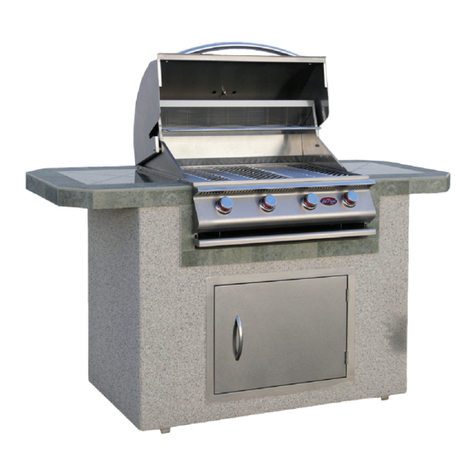
G Series Gas Grills
LTR50001050, Rev. E
Safety Instructions
www. c a l a m e b b q . c o m
1
C• al Flame™ grills are designed for outdoor
use only.
Never locate this appliance in an enclosed room, • under a sealed overhead structure, or in any
type of enclosed area such as a garage, shed, or
breezeway. Keep clear of trees and shrubs.
Do not place this grill under or near windows or •
vents that can be opened into your home.
Cal Flame™ grills are not intended for installation •
in or on recreational vehicles or boats.
Maintain sufcient distance as to not overheat any •
overhead combustible material such as a patio
cover.
The area surrounding your new grill should be •
kept clean and free from ammable liquids and
other combustible materials such as mops, rags or
brooms, as well as solvents, cleaning uids, and
gasoline.
Do not use the grill, grill cabinet, or area surrounding •
the grill as a storage area for ammable or plastic
items. Do not store the liquid propane (LP) cylinder
in the vicinity of this or any other appliance when
it is not being used.
the grill and is visible when the hood is lowered or
on the right side of the chassis. There is an area
on the back cover of this manual where you can
write down this information.
We recommend that a licensed contractor install •
your Cal Flame™ grill. Installation must conform
to local codes, or in the absence of local codes,
with either the National Fuel Gas Code, ANSI
Z223.1 / NFPA54, Natural Gas and Propane
Installation Code, CSA B149.1, or Propane
Storage and Handling Code, B149.2), as
applicable.
To prevent re and smoke damage, remove all •
packaging material before operating grill.
Before you start cooking, clean the entire grill •
thoroughly with hot, soapy water. This is necessary
to remove residual solvents, oil and grease used
in the manufacturing process. The grates should
also be thoroughly cleaned in the same manner.
WARNING: Improper installation, adjustment, alteration, service or maintenance
can cause injury or property damage. Read the installation, operating and maintenance
instructions thoroughly before installing or servicing this equipment.
DANGER
What To Do If You Smell Gas
Shut off gas to the appliance.•
Extinguish any open ame.•
Open lid.•
If odor continues, keep away from the •
appliance and immediately call your
gas supplier or your re department.
Safety Instructions
Placement and Location
Set-Up
Operation
Before installing built in grills in enclosures, copy •
all product information such as model number,
serial number and type of grill (e.g. natural gas
or LP) and store information in a safe place. This
information is located on a plate located behind
Do not use grill for oth
• er than intended use.
In the event that a burner goes out, turn burner •
knobs to the full OFF position, fully open the grill
hood and let it air out. Do not attempt to use the
grill until the gas has had time to dissipate.
Never use the grill if the drip pan is not properly •
installed. Drip pan should be pushed all the way
to the rack located just under the grill. Fire or
explosion can result from an improperly installed
drip pan.
Never use the grill or side burner in windy • conditions. If used in a consistently windy area a
windbreak will be required. Always adhere to the
specied clearances listed in this manual.
Keep any electrical supply cords and the fuel •
supply hose away from any heated surfaces.
Never line the grill or side burners with aluminum foil.•
When the unit is not in use, be sure to turn off the •
gas at the LP tank.
Do not install or operate your grill unit in such •
a manner that the cross ventilation openings are
blocked. Fresh air must be able to pass though
installed vents to safeguard against residual gas
accumulation. Failure to allow proper ventilation
may cause re or explosion.






























